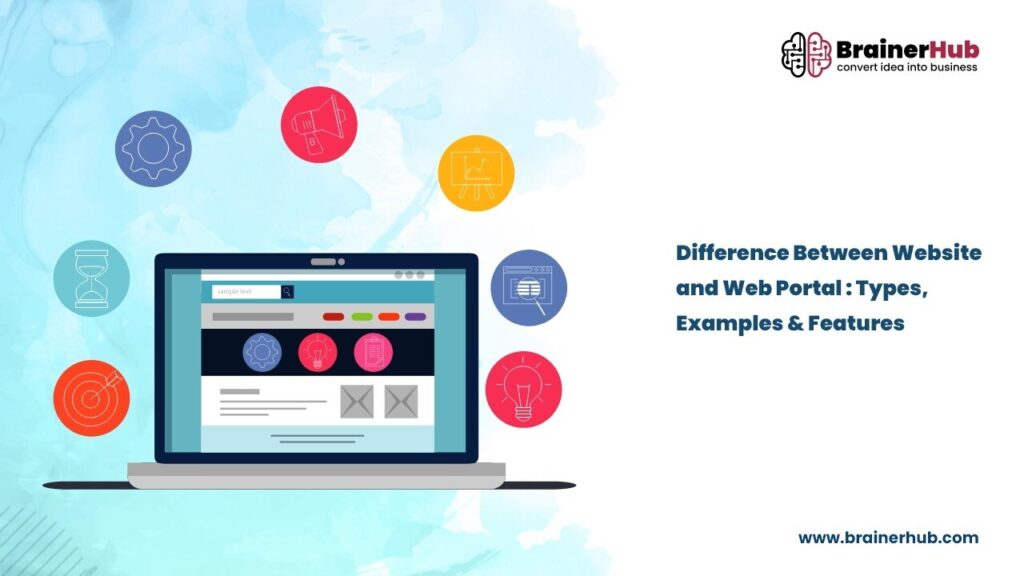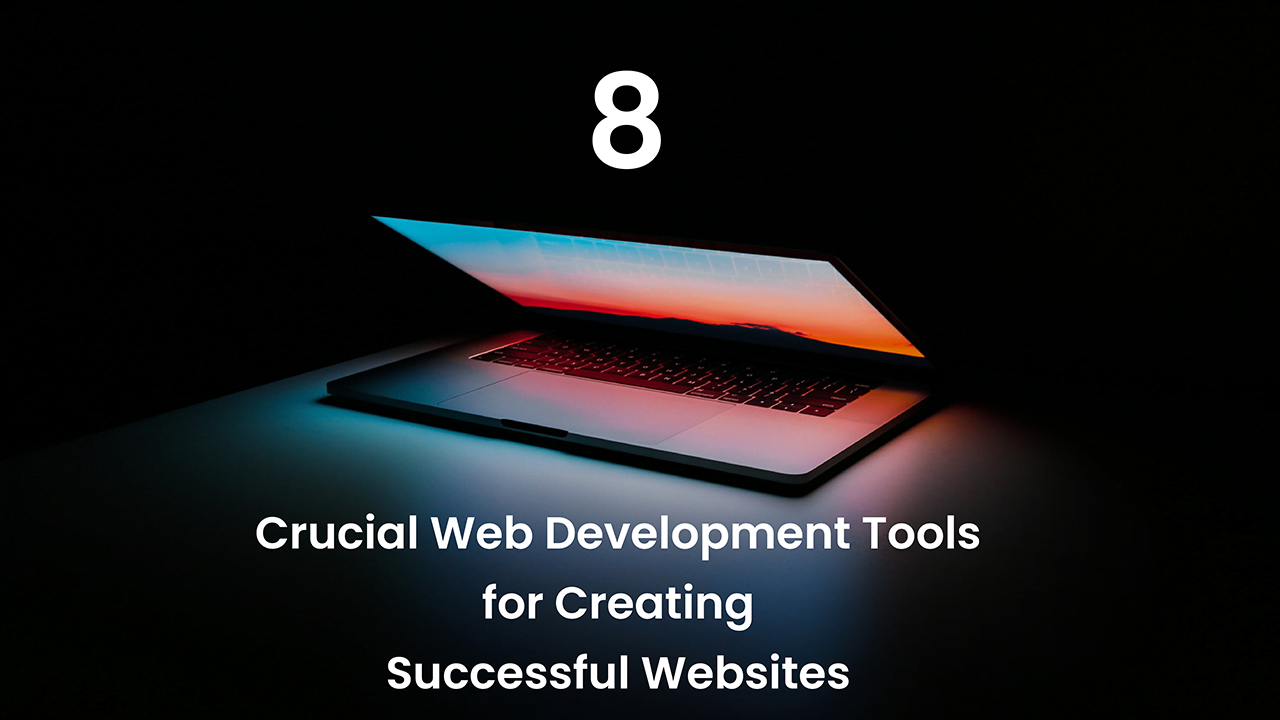What is a Web Portal?
A web portal is a website acting as a single access point to information and services from various sources. It is designed to provide users with a personalized and interactive experience by offering a range of features such as news, email, search engines, forums, and other applications. Businesses and organizations often use web portals to provide employees, customers, and partners with a centralized location for accessing information and resources. Individuals can also use them as a starting point for browsing the internet and managing their online activities. Overall, web portals are an efficient and convenient way to access information and services from multiple sources in one place.
Top 10 Web Portal Examples and Types
There are various web portals examples, such as corporate, government, educational, e-commerce, and more. Some famous examples of web portals include Yahoo!, MSN, AOL, and Google. These portals act as a gateway to information, services, and resources on the internet.
1. Web Portal for Faculty and Students
A web portal is a single access point to various web resources, which can be customized according to the user’s preferences. Examples of web portals for faculty and students include Blackboard, Canvas, and Moodle. These platforms provide a centralized location for course materials, assignments, grades, and communication between instructors and students.
2. Web Portal For Patients And Intranet
There are various types of web portals, and two popular ones are patient portals and intranet portals. Patient portals allow patients to access their medical records; communicate with healthcare providers, schedule appointments, and more. Intranet portals are organizations’ internal communication systems for sharing information and collaborating within their workforce. Both types of portals can improve communication and streamline processes.
3. Bank and Consumer Portals
This type of web portals are increasingly popular among banks and businesses, providing customers with a convenient and secure platform to access their services online. For instance, banks offer web portals where customers can manage their accounts, pay bills, transfer funds, and more, all from their homes. Similarly, consumer portals allow users to access various services through a single platform, such as online shopping, customer support, and account management. Such examples of web portals include Amazon, eBay, and PayPal.
4. Web Portal for Partners
Web portals are a popular way for businesses to access information and services to their partners. Types of web portals include customer portals, vendor portals, employee portals, and partner portals. Partner portals are designed to streamline communication and collaboration between a company and its partners, allowing them to work together more efficiently.
5. Government Web Portal
A government web portal is a type of web portal that serves as a gateway to access various government services and information. It provides citizens a platform to interact with government agencies and access resources such as tax filing, license applications, and public records.
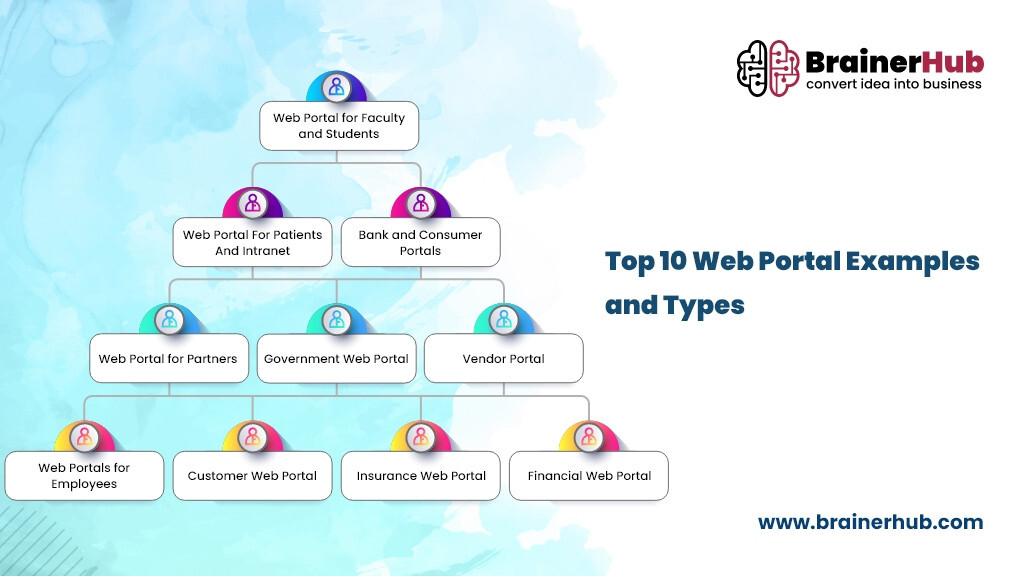
6. Vendor Portal
A vendor portal is a type of web portal that provides vendors with a centralized platform to manage their interactions with a company. It lets vendors view purchase orders, submit invoices, track payments, and communicate with the company’s procurement team. A vendor portal streamlines the procurement process, improves transparency, and strengthens vendor relationships.
7. Web Portals for Employees
Web portals for employees are secure online platforms that allow employees to access company information, documents, and tools from anywhere. Such portals include Microsoft SharePoint, Salesforce Community Cloud, and IBM Digital Workplace. These portals provide employees with centralized access to company resources, making it easier for them to collaborate and stay informed.
8. Customer Web Portal
A customer web portal is a type of web portal that allows customers to access information and services related to a company or organization. It typically provides a user-friendly interface for customers to manage their accounts, place orders, track shipments, submit support tickets, and access FAQs or knowledge base articles. The web portal can also offer personalized content and recommendations based on the customer’s preferences and purchase history.
9. Insurance Web Portal
An insurance web portal is an online platform that enables customers to access various insurance services, such as purchasing policies, submitting claims, and managing their accounts. Examples of insurance web portals include Geico, Progressive, and Allstate, among others. These platforms are designed to simplify the insurance process and provide customers with a seamless experience while interacting with insurance providers.
10. Financial Web Portal
A financial web portal is an online platform that provides users with a centralized location to access and manage their financial information. It typically includes account aggregation, budgeting tools, investment tracking, bill payment, and financial news. An example of a financial web portal is Mint.com, which allows users to link their accounts from various financial institutions and view all their financial information in one place.
Features of Web Portal
A web portal is a website that provides a variety of information and services to its users. Some standard features of a web portal include personalized content, log in and registration, search functionality, news and updates, forums and discussion boards, and e-commerce capabilities. The goal of a web portal is to provide a centralized location for users to access information and engage with the community.
Customized Interactions
Customized Interactions are a great web portal feature to have in a web portal. It gives users a personalized experience based on their preferences and behavior. With Customized Interactions, users can tailor their interactions with the portal to suit their needs and make their browsing experience more efficient and effective. This feature can also help businesses provide a more personalized service to their customers, leading to increased customer satisfaction and loyalty. Overall, Customized Interactions is a valuable addition to any web portal.
Content Collection
Content Collection is a valuable web portal feature that allows users to store, organize, and share various types of content, such as documents, images, videos, and audio files. This feature enables users to access their content from anywhere and anytime, as long as they have an internet connection. With Content Collection, users can create folders and subfolders to keep their content organized, set permissions to control that can access and edit the content, and collaborate with others by sharing content or working on the same document simultaneously. Overall, Content Collection is a valuable tool for web portals that want to provide users with a centralized and secure space to manage their digital assets.
User Friendly
User-friendliness is a crucial feature of any web portal. A user-friendly web portal is easy to navigate, intuitive to use, and provides a seamless experience for the user. Designing a user-friendly portal requires understanding the user’s needs, preferences, and behaviors. A well-designed user interface, clear and concise content, and easy-to-use features are critical aspects of a user-friendly web portal. In addition, a user-friendly portal should be accessible on multiple devices and platforms, providing a consistent experience across all channels. A user-friendly portal enhances user experience and helps increase engagement, loyalty, and business success.
Personalization
Personalization is a crucial web portal feature that allows users to customize their experience based on their preferences and interests. With personalization, users can access content and services that are most relevant to them, saving time and improving satisfaction with the portal. Some common examples of personalization features include personalized news feeds; recommended content based on browsing history and behavior, and customized dashboard views. Personalization can help enhance the user experience, increase engagement, and drive user loyalty.
Agility
Agility is a crucial feature for any web portal. It refers to the ability of a portal to adapt quickly to changes in the environment, user needs, and business requirements. An agile portal enables organizations to respond rapidly to market demands, customer needs, and industry trends. It facilitates faster decision-making, reduces time-to-market, and enhances customer experience. An agile web portal must have a flexible architecture, modular design, and scalable infrastructure to support dynamic changes. It should also support continuous integration and deployment, real-time analytics, and user feedback to improve the portal’s responsiveness and usability. Agility is crucial for web portals to stay relevant and competitive in today’s fast-paced digital landscape.
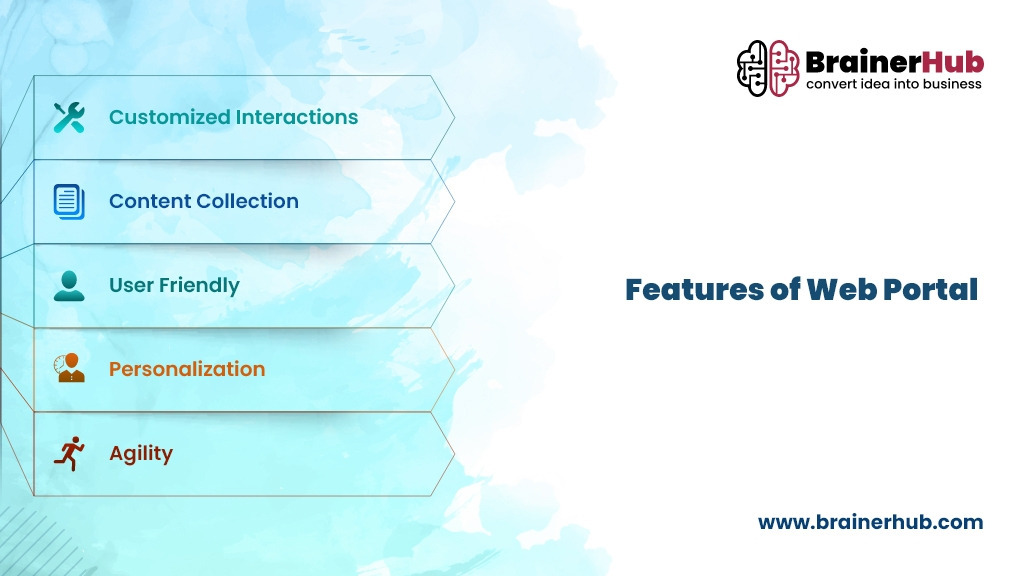
Difference between Website and Web Portal
Website | Web Portal |
A website can be a collection of related web pages accessed through a single domain name or URL. | A web portal is a website that acts as a single point of access to information from multiple sources. |
The primary objective of a website development is to provide information about a company, organization, product, or service to the targeted audience. | A web portal’s primary objective is to provide users with a personalized experience and offer them various services and information from different sources. |
A website can be static or dynamic and has various interactive features such as forms, search boxes, and multimedia content. | A web portal is generally dynamic and has advanced features such as user authentication, content management, and customization options. |
Websites can be designed for various purposes such as e-commerce, blogging, news, entertainment, education, etc. | Web portals are usually designed for specific purposes such as enterprise portals, government portals, educational portals, etc. |
Websites are generally simple and easy to navigate and have a straightforward structure. | Web portals can be complex and have a hierarchical structure with multiple levels of access and content. |
Websites are primarily focused on providing information and promoting products or services. | Web portals are focused on providing a collaborative platform for users to interact with each other and share information. |
Anyone with an internet connection can access websites. | Web portals require user authentication to access the content and services. |
Websites can be optimized for search engines to improve their visibility and ranking. | Web portals may not be optimized for search engines since they require user authentication to access the content. |
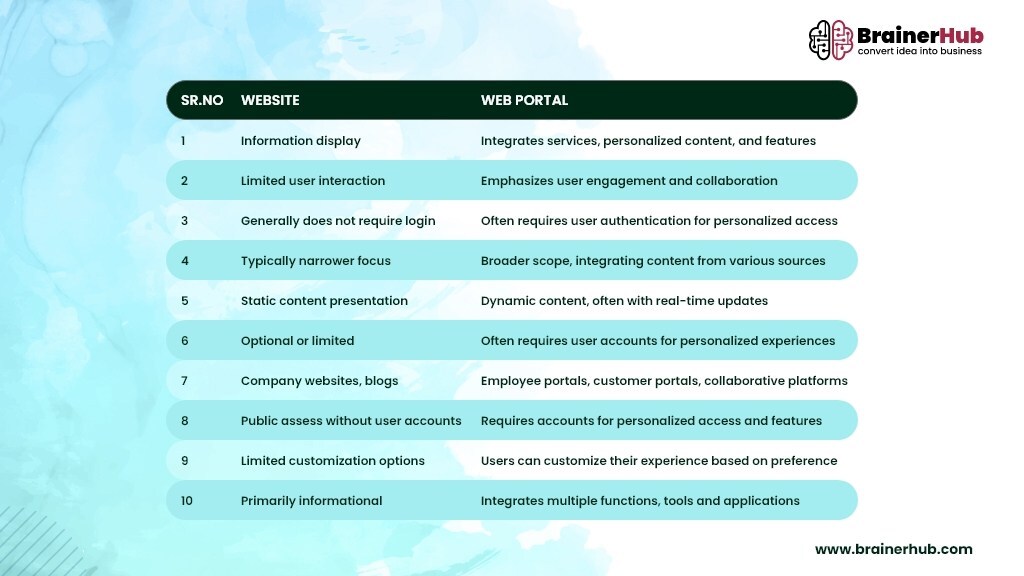
To Conclude
After comparing web portals and websites, both have their unique features and benefits. Web portals are designed to provide access to various resources and services, while websites are typically focused on providing information about a particular topic or business. Portals offer more interactive features, such as user accounts, personalization, and collaboration tools, while websites are often more uncomplicated and straightforward. Ultimately, the choice between a web portal and a website depends on the organization’s or individual’s specific needs and goals. We recommend trying BrainerHub Solution’s service for the same.
FAQs
Google is a search engine that provides users with access to vast information on the internet. While it offers several other services, such as email and cloud storage, it is not typically classified as a web portal. A web portal is a website that provides a variety of services and resources, often targeting a specific audience and providing a central point of access to these resources.
A web portal is a website that offers a wide range of services and information from different sources in a single location, often organized in a user-friendly way. It may include features like email, news, search engines, and other interactive tools, making it a centralized hub for accessing various online resources.

